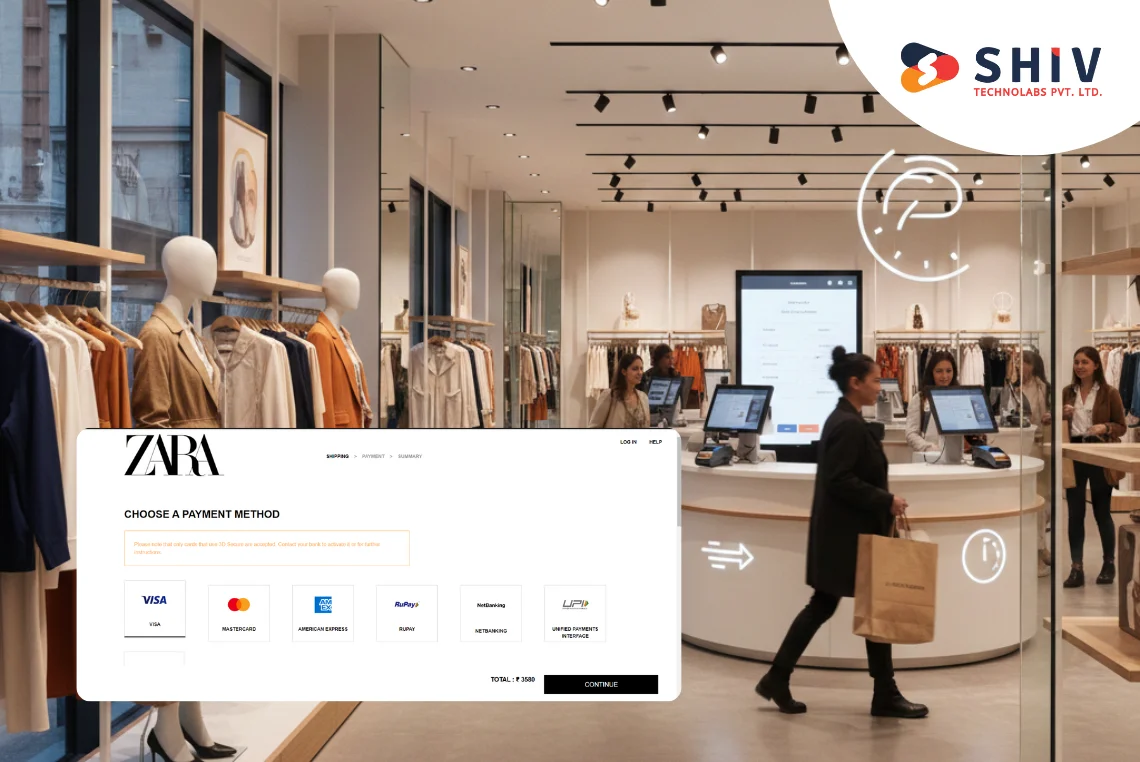Table of Contents
In the world of eCommerce, a high conversion rate is a crucial indicator of how well your website turns visitors into customers. This metric measures the percentage of users who complete a desired action, such as making a purchase, subscribing to a newsletter, or filling out a contact form. A successfuleCommercesite will see a higher conversion rate, which directly impacts sales and revenue.
In thee Commercesector, the significance of achieving a high conversion rate cannot be overstated. Studies reveal that a mere 1% increase in conversion rate can have a substantial impact on a business’s bottom line. For instance, if aneCommercesite generates $1 million in revenue with a 2% conversion rate, increasing this rate to 3% could potentially add an extra $500,000 in revenue, assuming traffic remains constant. This underscores the importance of implementing effective strategies in your eCommerce development efforts to boost these critical metrics.
Moreover, recent data shows that 79% of online shoppers who experience difficulties with website performance are unlikely to return. This underscores the necessity for a user-friendly and efficient online experience. Investing in high-quality eCommerce development not only improves conversion rates but also builds long-term customer loyalty. By focusing on creating an optimal shopping environment, businesses can significantly increase their ability to convert visitors into paying customers, thereby driving both growth and profitability.
What qualifies as a high conversion rate can vary by industry, but generally, a conversion rate of 2-3% is typical. Top-performingeCommercesites often achieve rates of 5% or more. Reaching these levels requires a deep understanding of your audience and a well-optimized website experience.
10 Strategies to Achieve a Higher Conversion Rate

Increasing youreCommercewebsite’s conversion rate involves a multifaceted approach, focusing on different elements of user experience and engagement. Here’s an in-depth look at ten effective strategies to improve your conversion rate:
1) A/B Testing
A/B testing, or split testing, involves comparing two versions of a webpage to determine which one performs better. This method helps in identifying the most effective elements for increasing conversions.
- Create Variations: Develop two versions of a webpage element—such as a headline, button color, or product image—to test their impact on user behavior. For instance, you might test a “Buy Now” button against a “Shop Now” button to see which leads to more purchases.
- Analyze Results: Use analytics tools to track key performance indicators (KPIs) such as click-through rates, conversion rates, and user engagement. Identify which version drives higher performance and implement the successful elements.
2) Improve Page Load Speed
Page load speed is crucial for maintaining user interest and reducing bounce rates. Faster loading times can directly influence the likelihood of conversion.
- Optimize Images: Compress and resize images to decrease their file size without sacrificing quality. This reduces the time it takes for images to load, which is crucial for maintaining user engagement.
- Minimize HTTP Requests: Combine multiple CSS and JavaScript files into a single file to reduce the number of server requests. This approach can improve loading times by decreasing the number of files that need to be downloaded.
- Use Browser Caching: Implement browser caching to store frequently accessed resources locally on the user’s device. This means that returning visitors will experience faster load times since they don’t need to reload these resources.
3) Clear and Compelling CTAs
Effective calls-to-action (CTAs) guide users toward completing desired actions on your website, such as making a purchase or signing up for a newsletter.
- Make Them Stand Out: Position CTAs in prominent locations where they are easily noticeable, such as above the fold or at the end of key content sections. Use contrasting colors and bold fonts to make the CTAs visually distinct.
- Use Persuasive Language: Write CTA text that clearly communicates the benefit to the user and creates a sense of urgency. Phrases like “Claim Your Offer” or “Start Your Free Trial” can be more compelling than generic terms like “Submit.”
4) Simplify Navigation
Easy-to-use navigation is essential for guiding visitors through your site and helping them find what they’re looking for without frustration.
- Organize Menus: Arrange menu items in a logical hierarchy. For example, create main categories such as “Products,” “Services,” and “Support,” and then use subcategories to organize related items. This helps users find specific information quickly.
- Include a Search Function: Implement a search bar that allows users to directly enter keywords to find specific products or information. Ensure that the search results are accurate and relevant to enhance user satisfaction.
Also read : 12 Biggest eCommerce Myths That Are Misguiding You
5) Offer Free Shipping
Free shipping can be a powerful incentive that encourages users to complete their purchases.
- Set Minimum Purchase Thresholds: Offer free shipping on orders that exceed a certain amount. For instance, provide free shipping for purchases over $50 to increase the average order value.
- Promote Free Shipping: Highlight the free shipping offer prominently on your website, including on product pages, in the shopping cart, and during the checkout process. This ensures that users are aware of the offer and are encouraged to meet the threshold.
6) Optimize Product Pages
Product pages need to provide comprehensive information and appealing visuals to persuade users to buy.
- Use High-Quality Visuals: Display multiple images of the product from different angles and in various contexts. Including zoom functionality and 360-degree views can give users a better understanding of the product’s appearance and features.
- Provide Detailed Descriptions: Write detailed product descriptions that cover key features, benefits, and specifications. Include information that answers common questions and addresses potential concerns to help users make informed decisions.
7) Implement Exit-Intent Popups
Exit-intent popups can help recover potential sales by engaging users who are about to leave your site.
- Offer Incentives: Use exit-intent popups to present users with special offers, such as discounts or free trials, as they attempt to exit the site. For example, offer a 10% discount on their first purchase if they complete the transaction before leaving.
- Request Feedback: Include a brief survey or feedback form in the exit-intent popup to understand why users are leaving. This information can help you identify and address issues that may be affecting conversion rates.
8) Personalize User Experience
Personalization can improve user engagement and increase conversion rates by making users feel valued and understood.
- Show Relevant Recommendations: Use data from user behavior, such as past purchases or browsing history, to recommend products that align with their interests. Personalized recommendations can encourage users to explore more and make additional purchases.
- Send Targeted Emails: Create email campaigns that offer personalized content based on user activity. For example, send follow-up emails with product suggestions or discounts to users who have abandoned their shopping carts.
9) Utilize Social Proof
Social proof can build trust with potential buyers and encourage them to complete their purchases.
- Feature Reviews and Testimonials: Display customer reviews and testimonials on product pages to provide social validation. Positive feedback from previous buyers can reassure new customers about the quality and reliability of your products.
- Showcase User-Generated Content: Highlight photos, videos, or reviews from customers using your products. This user-generated content can act as endorsements and help demonstrate the popularity and effectiveness of your products.
10) Improve Mobile Experience
With a significant portion of users accessing websites via mobile devices, providing a user-friendly mobile experience is crucial.
- Ensure Responsive Design: Make sure your website adapts to various screen sizes and orientations. Test the site on different devices to ensure that all elements are properly displayed and functional on mobile screens.
- Simplify Checkout: Streamline the mobile checkout process by reducing the number of steps and minimizing form fields. Use features like auto-fill for shipping and payment information to make the process faster and more convenient.
Essential Factors Impacting Conversion Rate
Achieving a higher conversion rate involves several factors. Understanding these elements can help you improve your website’s effectiveness in converting visitors into customers. For those using platforms like Shopify, integrating best practices in Shopify development can play a crucial role. Let’s look at some of the most important factors:
1) User Experience (UX)
The design and layout of your website significantly impact how users interact with it. Key considerations include:
- Easy Navigation: Your website should have a straightforward structure, making it easy for users to find what they’re looking for. Menus should be organized logically, and key sections such as search and contact information should be readily accessible.
- Clean Layout: A clear and organized layout helps users focus on important elements like product listings and calls to action. Avoid clutter to reduce frustration and guide users towards completing desired actions.
Mobile Optimization : Given the growing number of mobile users, it’s vital to have a mobile-friendly website:
- Responsive Design: Ensure your site adjusts to different screen sizes. Text, images, and navigation elements should be easily viewable on mobile devices.
- Fast Loading Times: Mobile users expect quick load times. Compress images and minimize the use of heavy files to keep loading times short and improve user experience.
2) Product Information and Presentation
Visuals play a crucial role in online shopping by helping customers understand products:
- Multiple Angles: Show products from different angles to give a comprehensive view. Allow users to zoom in on images for a closer look.
- Product Videos: Videos can demonstrate the product in use, offering a better understanding of its features and benefits. This is particularly useful for complex items.
Detailed Product Descriptions : Effective product descriptions can persuade customers to make a purchase:
- Highlight Features: Clearly outline the main attributes and specifications of the product. This helps customers understand what they are buying.
- Explain Benefits: Describe how the product solves a problem or improves the customer’s life. This connects the product’s features with its practical applications.
3) Trust and Credibility
Building trust with potential buyers is essential:
- Display Ratings and Reviews: Allow customers to leave feedback and show ratings prominently. Positive reviews can reassure new customers about the quality of your products and your business’s reliability.
- Showcase Testimonials: Feature testimonials from satisfied customers. Personal endorsements can help persuade other visitors to make a purchase.
Security Measures : Reassure visitors that their personal and payment information is safe:
- SSL Certificates: Implement SSL certificates to encrypt data transmitted between users and your website. Displaying an SSL badge can help build trust.
- Trust Badges: Use badges from recognized security organizations to indicate that your site meets certain security standards and that transactions are protected.
4) Call-to-Action (CTA) and Conversion Path
Calls to action guide users towards completing desired actions:
- Visibility: Place CTAs in prominent locations where users are likely to see them. They should stand out from the rest of the content.
- Persuasive Language: Use strong, action-oriented language that encourages users to act immediately, such as “Buy Now” or “Subscribe Today.”
Simplified Checkout Process : A smooth and simple checkout process can reduce cart abandonment:
- Minimize Form Fields: Reduce the number of fields in your checkout forms to speed up the process. Ask for only essential information.
- Offer Payment Options: Provide a variety of payment methods to cater to different preferences, making it easier for customers to complete their purchases.
5) Personalization and Targeting
Customized recommendations can increase engagement and sales:
- Relevant Products: Use data from user interactions to suggest products that align with their interests and previous purchases.
- Targeted Emails: Send personalized emails based on user behavior, such as abandoned cart reminders or tailored product suggestions.
Behavioral Targeting : Responding to user behavior can help deliver more relevant content:
- Retargeting Ads: Use retargeting strategies to remind users who have visited your site but did not complete a purchase. These ads can bring users back and encourage them to buy.
- Behavior-Based Discounts: Offer special discounts or incentives to users who are about to leave the site, aiming to recover potential sales.
Also read : Top eCommerce Design Strategies to Maximize Your Online Store
Measuring the Success of Conversion Rate Efforts

To determine whether your strategies for increasing conversion rates are effective, it’s important to track and analyze performance. Here’s how to measure success:
# Set Clear Objectives
Establish specific, measurable objectives to assess the effectiveness of your conversion rate optimization efforts.
- Identify Key Metrics: Determine which metrics will help you evaluate success. Common metrics include conversion rate, average order value, and cart abandonment rate.
- Set Benchmarks: Use historical data to set realistic benchmarks for comparison. This helps in measuring improvements and understanding the impact of different strategies.
# Use Analytics Tools
Analytics tools can provide valuable insights into how your conversion rate strategies are performing.
- Track Key Metrics: Employ tools like Google Analytics or other web analytics platforms to monitor conversion rates, user behavior, and other relevant metrics. Set up goals and funnels to track user interactions and conversions.
- Analyze Trends: Examine trends in the data to identify patterns and factors that are influencing your conversion rates. This can help you understand what’s working and where adjustments are needed.
# Gather User Feedback
Direct feedback from users can provide insights into their experience and highlight areas for improvement.
- Conduct Surveys: Use surveys to gather feedback on user satisfaction, challenges, and suggestions for improvement. This can provide valuable information on how to enhance the user experience.
- Analyze Customer Support Interactions: Review interactions with customer support to identify recurring issues or concerns. Addressing these issues can help improve overall conversion rates.
# Perform Regular Reviews
Regularly review the performance of your conversion rate optimization efforts to ensure they are effective.
- Compare Results: Assess whether there have been improvements in conversion rates or other key metrics. Compare results with your benchmarks to determine the impact of your strategies.
- Adjust Strategies: Based on your analysis, refine or modify your strategies to address any issues or capitalize on successful tactics. Continuous refinement can help maintain and build on your improvements.
# Benchmark Against Competitors
Comparing your performance with industry standards or competitors can provide context and help you stay competitive.
- Analyze Competitor Strategies: Observe how competitors approach conversion rate optimization and identify best practices that you can incorporate into your own strategies.
- Adjust Based on Insights: Use insights from competitor analysis to refine your strategies and stay competitive in the market. Understanding how your performance stacks up against others can help you make informed decisions.
Conclusion
Achieving a higher conversion rate is a crucial goal for anyeCommercebusiness aiming to boost revenue and grow its customer base. By focusing on key areas such as A/B testing, page load speed, clear CTAs, simplified navigation, free shipping, optimized product pages, exit-intent popups, personalization, social proof, and mobile experience, you can make significant improvements to your site’s performance. Each strategy plays a vital role in creating a more engaging and effective user experience, ultimately leading to higher conversion rates.
Regularly reviewing and measuring the success of these strategies will help you understand what works best for your business. Using analytics tools, gathering user feedback, and monitoring key metrics will provide valuable insights into your conversion rate optimization efforts. By continuously refining your approach based on data and trends, you can maintain and build upon your successes.
At Shiv Technolabs, we understand the intricacies of improvingeCommerceconversion rates and driving growth for your online store. Our team of experts is dedicated to helping you implement these effective strategies to achieve higher conversion rates. If you’re looking to optimize your eCommerce site and increase your sales, consider partnering with us. Hire eCommerce experts who bring specialized knowledge and experience to tailor solutions that align with your business goals. Let us help you transform your online presence and boost your conversion rates. Reach out today to learn more about how we can support youreCommercesuccess!




















